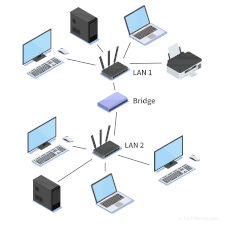Bridge
A bridge is a device that provides a connection between two or more local area networks. It allows devices on separate networks to communicate as though they were on the same LAN. A bridge may connect two networks of the same type (e.g. bridging two Ethernet networks) or two different types (e.g. bridging a Wi-Fi network and an Ethernet network).
Network bridges can take several different forms. Many bridges are dedicated hardware devices that only provide a bridge with no additional features; even though a bridge and a router may look similar, a bridge does not assign IP addresses, keep a log of network activity, or provide a firewall. Dedicated Ethernet bridges typically only have two ports to connect to and bridge two routers or switches. Most Wi-Fi bridges have a single Ethernet port and connect to a single Wi-Fi network, giving the device or network connected to the Ethernet port access to the Wi-Fi network as if they were the same network.
Bridges and gateways are similar networking devices that both allow separate networks to communicate. Bridges link two LANs that use the same protocol, and operate at the data link layer (level 2 of the OSI model); gateways link networks of different types and work across multiple OSI link layers, converting protocols when necessary.
NOTE: A computer with multiple network adapters may also function as a bridge through software. Windows, macOS, and Unix-based operating systems all include features that allow a computer to bridge two network connections, regardless of the type of connection.
 Test Your Knowledge
Test Your Knowledge